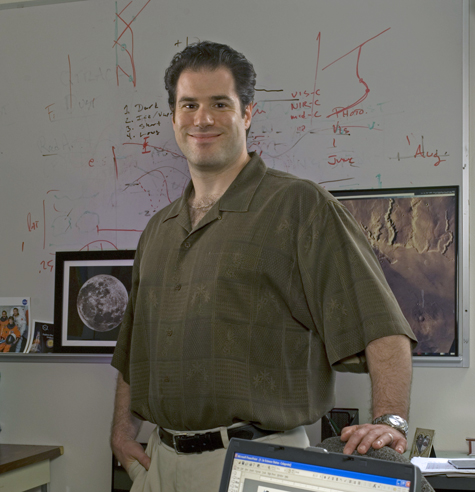Water on the Moon — Bring your Buckets!
Friday, November 13th, 2009
As usual, the LCROSS press conference had a lot of Power Point slides, but probably the most memorable thing about it was an empty 2-gallon industrial bucket. Tony Colaprete, the lead scientist for the mission, said: “I’m here today to tell you that yes, indeed, we found water on the moon, and we didn’t just find a little, but we found a significant amount.” Then he held up the bucket. ”In the 20-30 meter wide impact crater that LCROSS made, we found about a dozen of these 2-gallon buckets. And that is probably a lower bound.”
Let me back up and give a little bit of context. Earlier missions, Clementine and Lunar Prospector, had found evidence for water ice but no direct proof. This year, three different missions simultaneously reported proof of water ice, because they detected not just the spectral signature of hydrogen (H) but also the hydroxyl molecule (OH). [It doesn't take too much knowledge of chemistry to see that hydrogen, H, plus hydroxyl, OH, equals water, HOH.] Not only that, the hydroxyl comes and goes over the course of a lunar day, which suggests that there is some chemistry going on at the moon’s surface. Carle Pieters, the principal investigator for the Chandrayaan-1 mission’s Moon Mineralogy Mapper, estimated that you could get a liter of water from a football field-sized area of the moon’s surface. This was exciting news, but as a reality check, it still makes the moon drier than Earth’s driest desert.
LCROSS has found an oasis in the desert. It was targeted for a specific crater near the south pole, Cabeus, where remote sensors had detected a high concentration of hydrogen. It excavated a 30-meter crater, only a third the size of a football field. Within that region, it dug up not just a liter of water, but 100 liters. Again, for context, one reporter asked Colaprete how this compares with Earth’s driest deserts. He said, “If you stand on that beach [the sandy spot where LCROSS impacted], I can say that it is wetter than some deserts on Earth.”
Does this contradict the Chandrayaan-1 findings? Of course not. It just re-emphasizes how little we know. Chandrayaan-1′s measurements were taken over a broad swath of the moon. By comparison, LCROSS is just looking at a tiny pinprick on the surface. Also, Chandrayaan-1 was measuring only the water that is right at the surface, up to a few microns deep. On the other hand, LCROSS excavated to several meters below the surface. To me that was one of the most exciting things about LCROSS; unlike measurements from orbit, it really sees what is underground. (However, it turns out that I was not entirely correct when I thought that LCROSS would be the first mission to do this. Radar measurements can penetrate one or two meters. Chandrayaan-1 carried a radar instrument on board, but those results have not been published yet. When they do get published, Paul Spudis promises me that they will be good.)
So basically, we now have one data point where we had zero before. We know that at one particular location, we have found an oasis. It remains to be seen exactly how concentrated the water ice is there, how heterogeneous it is, how hard it is to find other areas with lots of water, how deeply it is buried, etc. Not only that, there is a whole new suite of questions: How does water get to the moon? Once it’s there, how does it get transported to the poles? There are lots of theories, and at this point absolutely no way to choose among them.
What we have here is the appearance, in less than two months (since Pieters’ paper), of a whole new field of science that didn’t exist before: lunar hydrology. The next step, of course, will be for the LCROSS team to continue analyzing their data and nail down the concentration of water at their impact site. Also, LRO (the Lunar Reconnaissance Observer) will continue making large-scale observations to figure out where else on the moon we might find water. But then, if we’re really serious about following up on this discovery, the next step needs to be a lunar rover (or even several of them) to poke around these permanently shadowed craters and start answering the questions in the previous paragraph.
There was one other very interesting thing mentioned at the press conference, which Colaprete was clearly eager to say more about but he just doesn’t have the data yet. LCROSS found lots of other volatile elements in the debris plume and/or the vapor cloud released by the impact. These may include:
- carbon dioxide
- methane
- methanol
- ethanol
- ammonia
- other organic molecules
The case for these is not as clear yet as the case for water. Colaprete said that it is absolutely certain that some of them are present, but they can’t yet pin down which ones and in what amounts. The science team is going to continue working hard to answer those questions, but they felt that the detection of water was so clear and of such overriding importance that they voted to go public with it now (instead of waiting another month, as per the original plan). But still, stay tuned for news about these other volatile compounds, because this story ain’t over yet.
